DISCLAIMER: The vast majority of this information is either directly quoted from the sources below or only slightly changed. Very little of it is my original thoughts, save a paragraph here or there. I attribute the following completely to my sources and make no claims otherwise. If so desired I will remove this content from the website without hesitation if asked to do so by TIMEGHOST or by any of the original copyright holders. My intent is purely the sharing of historical knowledge regarding Canada and the Battle of the Atlantic.
Sources:
“The Far Distant Ships” by Joseph Schull, ISBN-10 0773721606 (An official operational account published in 1950, a product of its time and somewhat “epic” in its retelling.)
“North Atlantic Run” by Marc Milner, ISBN-10 0802025447 (Written in an attempt to give a more strategic view of Canada’s contribution than Joseph Schull’s work, published 1985)
“Reader’s Digest: The Canadians at War: Volumes 1 & 2” ISBN-10 0888501617 (A compilation of articles ranging from personal stories to overviews of Canadian involvement in a particular campaign. Contains excerpts from a number of more obscure Canadian books written after the war, published 1969)
“The Corvette Navy” by James B. Lamb, ISBN 0-7737-3225-X, (A shorter book that contains personal anecdotes of Mr Lamb’s service aboard corvettes during the Battle of the Atlantic, and later his involvement in the D-day landings)
Pictures are courtesy of Wikimedia Commons, Library and Archives Canada, Uboat.net, The Rooms Provincial Photo Archive, and other sources. I only use photos that exist in the Public Domain unless otherwise stated.
Who’s Zone is it Anyway?, Where’d all the Americans go?, Oil Slicks to the Horizon
The exploits of the first training group were an auspicious start, and certainly a quantum leap forward from anything Murray’s command had enjoyed before. But the additional group needed to make a regular rotation possible never materialized. Instead, Prentice busied himself with exercising operational groups as they made their passage from St John’s to WESTOMP (West Ocean Meeting Point). It would not be until the 20th of May, six weeks after the first training cruise that Prentice was able to arrange a training program once again. The corvettes in this second group (Camrose, Galt, Sackville, and Wetaskiwin) were all fresh from refit. Like the first group they were exercised in towing, manoeuvring, gunnery, depth charges, and anti-aircraft. But they also were given time with the training submarine, P-514, in Conception Bay, the only place near St John’s where water conditions permitted effective asdic training. The second training program was also the longest of any given by Prentice; five days. It concluded with operations ‘in the vicinity of Convoy ON-95.’ The final supporting operation nearly ended in tragedy, illustrating again the problems of trying to train off Newfoundland, where the Labrador Current and Gulf Stream combine to produce almost perpetual fog.
Returning from exercises on the last day in a thick fog, one of Prentice’s group obtained an asdic contact. ‘Action stations’ were sounded, followed almost immediately by a report from Sackville that she too had obtained a target. In pursuit of these contacts the group soon split up. Each escort was equipped with SW1C radar, but since the sets needed to be directed towards a suspected target, keeping track of nearby corvettes was impossible without good bearings. Nonetheless, the sounds of action, such as Sackville’s depth-charging of her contact, could be heard clearly through the fog. In the best of naval tradition Prentice ordered Chambly’s helmsman to steer her ‘towards the sound of the guns.’ In a very short time Chambly passed through waters heavily laden with dead fish, silent testimony to the problems of contact classification.
The real excitement, however, soon followed when Sackville suddenly emerged from the fog on a reciprocal course, obviously intent on dealing the enemy another blow. The untimely demise of both ships was narrowly averted when they turned in the same direction. Parallel courses were assumed ‘close enough for each ship’s respective thrower parties to almost shake one another’s hands.’
All that Prentice was able to achieve with the fifteen or sixteen escorts which passed through his group was doubtless of great value. However, in hindsight there is cause for concern about the emphasis of his training philosophy. Canadian escorts needed to know the basics of cooperation and teamwork, but they also needed to know how to conduct a good defence of convoys. The latter problem, as distinct from learning the principles of teamwork, was largely untouched by Prentice’s training exercises. His emphasis was on effective ASW, a goal towards which Prentice was a tireless worker. Moreover, the offensive strike-force concept also lay at the base of the navy’s ASW doctrine and had since before the war. The specialization in safe and timely arrival of the convoy which characterized the RN’s Western Approaches Command was never taken up by the RCN, nor did it find a home in any of the separate RCN commands, until the end of 1943.

(HMCS Sackville in 2006. The only surviving member of the Flower-class, she was restored to her 1944 configuration in the 1980s after years of post-war service with the Canadian Department of Marine and Fisheries as a research vessel. She is moored alongside the Halifax Maritime Museum of the Atlantic during the summer months as a Museum ship, and is Canada’s official WW2 Naval Memorial.)
Shielded by the wing of US strategic and operational command in the Western Atlantic, the RCN was allowed to pursue these tendencies, which were in any event identical to those of the USN. It was a situation watched with considerable and growing interest by the Staff at Western Approaches. In fairness to both Prentice and the RCN, the future character of the U-boat campaign on Allied trade was by no means certain in the first half of 1942. Individual U-boats now operated inshore, relying extensively on their guns. The uncertain future of U-boat warfare was noted by the Canadian Chiefs of Staff at meetings with senior British and American officers in Washington in January 1942. But while U-boat tactics might change and alter the nature of defence against them from time to time, there was one constant and vexing problem: how to deal effectively with a cornered U-boat. Driving U-boats off was an effective means of defending trade and could be readily understood by all. But perfecting the business of sinking U-boats with certainty took long hours of hard practice. Not surprisingly, then, there was a tendency to concentrate on the offensive tasks of convoy escort, pursuit of nearby U-boats and hunting them to destruction. The idea was right, but in early 1942 it needed to be balanced with an equal measure of defence.
There is another aspect of this issue which warrants an examination in light of the failure of C Groups to meet British standards of performance in the latter half of 1942. In large measure the RCN’s most important battle was one for survival. Laurels were won by destroying the enemy, a point driven home to the RCN by its own minister in late 1943, and this could only be done by efficient ASW ships. Further, the navy’s long-term goals required the preparation of good all-round naval officers, men who could man the post-war navy. Training programs therefore stressed the traditional basics of gunnery, seamanship, and navigation. This was fine. But although the RCN was primarily an ASW navy by 1942, it had not yet truly begun to think like one. None of this meant that losses to shipping were inconsequential. The disaster of SC-42 was a nightmare to be avoided. Yet even Murray wanted his groups strong enough to take offensive action when threatened, and of course a good limited offensive was the best means of breaking up a pack attack. Unfortunately, the mere size of a group was no measure of the effectiveness of offensive action.
Finally, there is geographic determinant which separated North American and British views of Atlantic convoy battles. Both the Canadians and the Americans were prepared to accept a certain scale of losses from convoys in 1942, provided that the escort displayed an aggressive spirit in the face of enemy attack. For the Canadians and Americans, North Atlantic convoys were ‘operational’ in the same sense that the Murmansk or Malta convoys were to the British. For the British, the main Atlantic convoys were the lifeline of the nation, a perspective which gave a very different tone to their assessments of convoy battles. It is inconceivable, in any event, that the languishing state of efficiency and even of equipment in the escort fleet would have continued had Canada’s fate hung in the balance.
Despite the best intentions of Murray and the efforts of Prentice, the operational-training scheme was never fully developed. The reason, of course, was the continued expansion of commitments. By the end of April, as the British abandoned Burma and the Japanese extended their grip on the Solomon Islands, USN participation in MOEF was down to one escort group, A3, containing a token force of US Coast Guard cutters. In fairness, the cutters were all large, modern vessels of the Treasury class, albeit somewhat slow. The rest of A3 was mostly RCN corvettes. The reduction of USN commitment to MOEF finally forced a major reorganization of the force and convoy cycles.
From the end of April 1942 onwards the escort of convoys between WESTOMP and EASTOMP fell to eleven escort groups. Six British (B’s 1,2,3,4,6, and 7. B5 was on loan to the USN in the Caribbean), four Canadian (C’s 1-4), and A3. It should be noted however, that the national designation of each escort group was often nominal. One, A3, was mixed, and within the four C groups there was actually one full British group on loan (usually concentrated in C2) and initially several Free French corvettes. B groups frequently contained escorts from European navies-in-exile; B6, for example, had British destroyers and Norwegian corvettes. Fortunately. all except the USN followed British operational procedures. The lack of a common escort doctrine in MOEF was largely overcome by September 1942. By then the commander of Task Force Twenty-Four (CTF-24, as it became to be known) had begun to see the wisdom of British insistence on safe and timely arrival, while the new “Atlantic Convoy Instructions.” issued as a replacement for WAC1S in September, included USN screening diagrams. Thus, a meeting of minds was gradually affected in MOEF throughout 1942. But the continued existence of different procedures in A3 made it difficult for Allied captains to adapt quickly to working with the Americans.

(HNoMS Montbretia, a Flower-class corvette of the Royal Norwegian Navy. Photo belongs to the Marinemuseet.)
This meeting of minds was still some time off when the first convoy to sail under the new eleven-group arrangement departed in late April. Ironically, although American involvement in the escort of trade in the Northwestern Atlantic was now just a token, the USN retained operational control of convoys west of the CHOP (Change of Operational Command) line (roughly 26 degrees west) agreed to at the Argentia conference the previous August. Command continued to be exercised by CTF-24, now under the control of Vice-Admiral R.M. Brainard, who replaced Bristol following the latter’s untimely death on the 30th of April. Like his predecessor, Brainard was a very capable officer with a wide and varied service career. His most recent posts had included those of deputy chief of staff to Admiral King (USN) and, in March, commander of Amphibious Force, US Atlantic Fleet. The latter posting lasted barely a few weeks before Brainard was promoted to the rank of vice-admiral (temporary), which gave him sufficient seniority over the Canadian admirals at Halifax and St John’s, and was sent to replace Bristol.
The continued existence of CTF-24 meant that Atlantic convoy operations straddled two commands. It also meant that all Canadian naval operations outside the three-mile territorial limit (which in effect meant all of them) remained under a foreign admiral with few ships of his own. The incongruous situation of Canadian warships engaged against an enemy under the direction of a neutral commander now gave way to an equally incongruous situation. So long as the U-boats were busy elsewhere, the potential problems of dual control did not arise, and the Canadians were content to leave the command structure unchanged. The British, however, were never very pleased about the arrangement and sought to have it changed. They made an official request in January, but Admiral King was unprepared to tamper with something that was at least working at a time when so much else was going wrong. King’s logic thus defeated initial British attempts to re-extend C-in-C, WA’s control of escort operations once again to the shores of Newfoundland.
For the moment the RN let the matter rest. However, the issue was aired internally at the Admiralty in May, when it was suggested, as a means of levering control from CTF-24, that the Canadians might be given responsibility for the area west of WESTOMP. It was only with ‘considerable reluctance’ that the British once again let the matter rest unchallenged. In time the shifting pattern of war would bring the necessary impetus for change. There were several other noteworthy developments that resulted from the reduction of MOEF to eleven groups and the adoption of the great-circle route as the mean line of advance for convoys. The latter streamlined escort arrangements considerably, permitting the redistribution of forces to more active theatres. The dispersal was largely permanent. Coverage of the whole Newfoundland to Ireland stretch by a single escort force substantially reduced the tactical flexibility of the escort groups since they had to be cautious not to leave the convoy under-guarded as a result of escort’s having to detach early to seek fuel.
This severely limiting factor also hampered convoy routing, making the convoys more susceptible to interception. In early 1942 these considerations were overshadowed by the grave need for escorts in other theatres. As the year wore on, some measure of flexibility was restored through the introduction of refuelling at sea (never reliable in 1942), the formation of Western Support Force, and adjustments to WESTOMP. In the meantime, however, the enemy took considerable advantage of the inflexibility and scored some real successes as a result of the triumph of his ulterior strategy, dispersal of Allied escort strength.
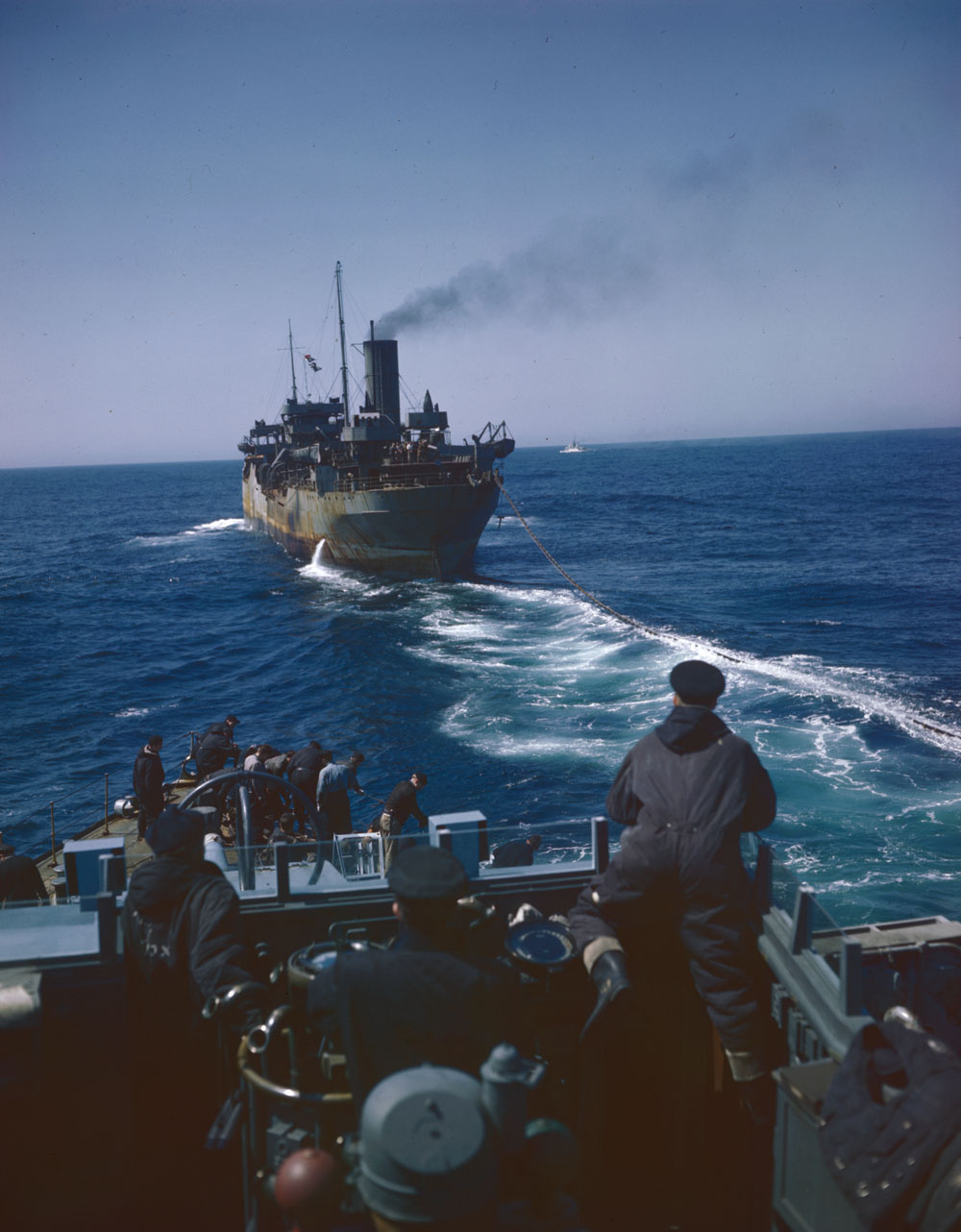
(A Canadian corvette refuelling at sea from a Tanker. The trailing fuel line is visible. Sometime between 1942-1945.)
For the time being all eyes focused on the plight of shipping along the US east coast, and their direction of Allied forces continued. Through April and May the Canadian contribution to MOEF was spared further large losses, though corvette strength was reduced to forty in April when Chicoutimi, Sudbury, and Summerside were sent to WLEF. Baddeck followed them in May, but her place was taken by Sackville, so the figure remained steady until the end of the month. However, further large relocations of corvette strength were in the pipeline in May as a result of dwindling oil stocks in eastern Canada and Newfoundland. Nearly half of Canada’s domestic oil supplies were imported by tanker from the Gulf of Mexico and the Caribbean, areas under heavy German attack by the late spring.
Although the movement of traffic from the Caribbean to northern waters was ostensibly a USN responsibility, American inability to defend tankers engaged in trade with Canada forced the RCN to consider the establishment of her own Halifax-to-West Indies convoys. To meet these and other WLEF commitments an additional eight corvettes were assigned to WLEF from MOEF in early June. But the Naval Staff wanted and needed more in order to put the oil convoys on a firm footing, and petitioned both Murray and Jones, suggesting two possible source for yet more escorts.
One possibility was to curtail training by ending the practice of sending new commissions, three at a time, to the RN’s escort work-up base, HMS Western Isles, at Tobermory, Scotland. It is noteworthy that NSHQ was quite prepared to use the negative effects of its own manning policy as a means of securing agreement for discontinuing the use of Tobermory.
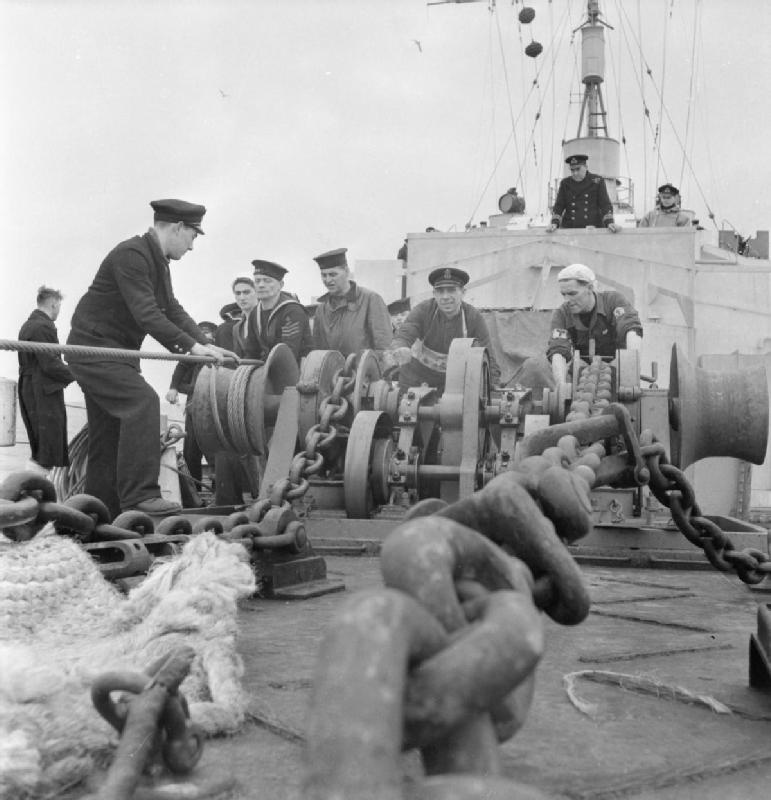
(Sailors aboard training ship HMS Western Isles prepare to launch a cable to tow a damaged ship during a training exercise near Tobermory on the Isle of Mull.)
“Due to the necessary rapid changes in personnel in RCN corvettes,” NSHQ observed, “it appears that some of the value of this training is lost.” The other alternative offered by NSHQ was to withdraw ‘a number of RCN corvettes from C and A groups’ which NSHQ maintained still had sufficient strength for 10.8 escorts per group. This was true, but only if allowance was made for inclusion of escorts undergoing refits. Jones, whose command was increasing in size and importance, recommended that training at Tobermory be suspended, at least temporarily. ‘Local training will continue,’ he replied ‘and is of increasing value.’ This was true enough, and Commander J.C. Hibbard (transferred from command of Skeena to Halifax as training officer in March) had managed to make considerable headway. But Murray was not so matter-of-fact about either alternative. In a long reply he advised the Naval Staff of the importance of proper training:
“Considering that Tobermory training doubles morale and efficiency and cannot be duplicated elsewhere. Lack of training allows convoys to be attacked without consequent submarine losses.”
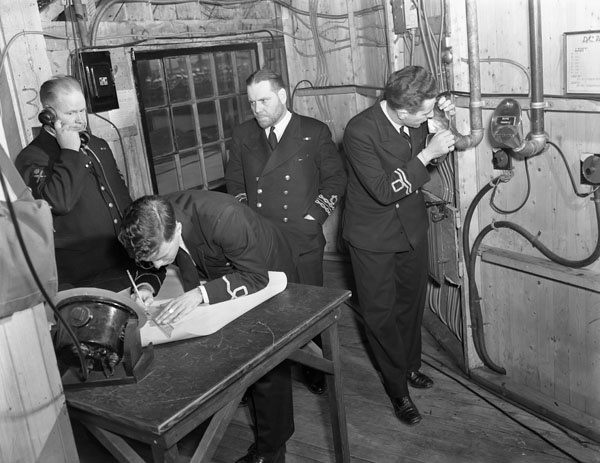
(Unidentified officers using the night firing trainer, HMCS Cornwallis [shore installation], Halifax, 1942.)
As for reducing the size of his escort groups, Murray warned that ‘Groups should sail from St John’s at full strength which should not be less than six ships and preferably eight if we are to avoid a repetition of SC-42 losses.’ The inequality of group size between WLEF and MOEF cited by NSHQ (WLEF averaged only half that of MOEF) was totally justifiable in Murray’s opinion by virtue of WLEF proximity to both air and surface reinforcement. Moreover, the operational strength of C groups was roughly equal to that ‘which the Admiralty considers necessary for B groups employed in the same area.’ As a parting shot Murray reminded NSHQ that the US contribution to A3 was not three destroyers but actually only two Coast Guard cutters, whose margin of speed over corvettes was almost negligible.
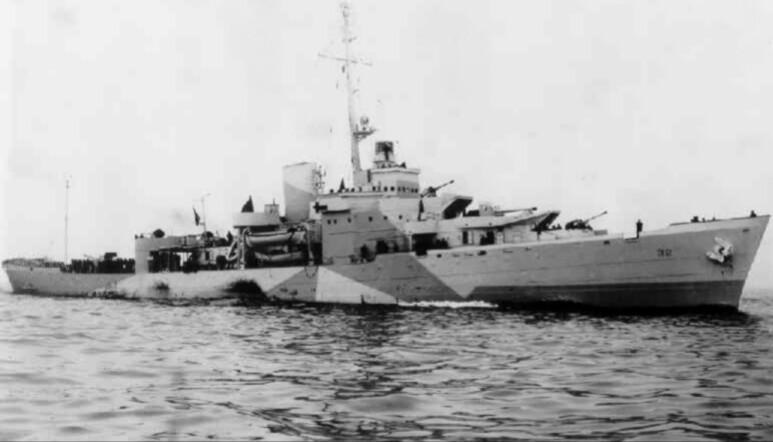
(USCGC Campbell, Treasury-class cutter, photograph taken off Argentia, Newfoundland, Winter of 1942.)
Murray’s concern for the continuance of Tobermory training was echoed by the director of ASW at NSHQ, Commander A.R. Pressey, RCN. Contrary to what was implied in Jone’s reply, Pressey advised the Naval Staff on the 1st of June that facilities at Halifax were still inadequate, particularly with regard to training submarines, which were in short supply. In fairness to Jones, Hibbard was on the verge of some very important work, including realistic convoy exercises and development of the ‘Night Escort Trainer’ or NET. The NET was a synthetic training device designed to replicate the bridge of an escort at night during a U-boat attack, right down to the occasional bucket of salty water hurled at a bridge mock-up by a member of the training staff. However, the training program at Halifax was still a long way from being adequate in the summer of 1942, and, in fact, few of the escorts which fought battles later in the year passed through Hibbard’s command. In the event, the Naval Staff concurred with Pressey’s assessment and instructed that the dispatch of corvettes to Tobermory not be tampered with. Instead the Staff settled on the second alternative. On the 15th of June Murray was asked to part with eight more corvettes, 16% of his operational strength.
The genesis of this reduction lay in the unchecked spread of the U-boat campaign and was by no means unilateral on the part of the RCN. The British estimated that 280 ships, nearly half of them tankers, totalling 1,650,752 gross tons were lost to enemy action between January and May 1942, most of them in the Western Atlantic. The British concern about American delays in establishing convoys was justified, as was their frustration at not being able to intervene effectively. The RCN had both the intelligence and the infrastructure at its disposal to set up an interlocking convoy system off the US and in the Caribbean, although some American assistance would be required initially. Ottawa contented itself with its routing and diversion duties, which included prohibiting the movement of all Commonwealth trade south of New York. Similar action was taken by the Jamaica Intelligence and Trade Centre, which routed all Commonwealth Gulf of Mexico and Caribbean traffic to Britain via Africa.
German attacks on the oil trade were their most intense, and this factor more than any other finally forced American authorities to adopt convoy. Donitz had hoped to cripple American industry by shutting off its supply of petroleum, and he very nearly succeeded. Its effects were important in the long term, when the shortage of tankers threatened to restrict British industry later in the year. In the late spring of 1942 the heavy loss of tankers seriously disrupted movement of oil to Allied consumers, including Canada, and forced both Commonwealth nations to take independent action to protect their own supplies. In early May B5 began to escort oil convoys between Aruba, in the Dutch East Indies, for eventual passage to the UK via Sierra Leone. The RCN followed suite on the 22 of May, escorting convoys from Halifax to Trinidad and then later to Aruba.
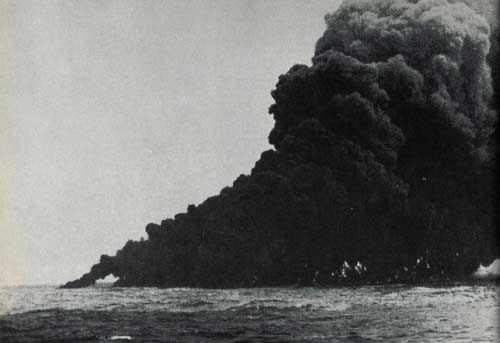
(Norwegian Motor Tanker Koll aflame, torpedoed the 6th of April 1942 by U-571 off Cape Hatteras.)
The gradual shifting of escort strength southwards did not lessen American appeals for aid. Even as the corvettes designated for the oil convoys lay in wait at Halifax, Admiral H.R. Stark, formerly chief of Naval Operations (American equivalent of CNS), now commander of US Naval Forces in Europe petitioned the Admiralty for more escorts. The British were in something of a quandry. They believed that the Americans problems were largely organizational. They were also gravely concerned about the main trade routes between Newfoundland and Britain. Although these were still enjoying respite from sustained attack, it was not expected to last. Moreover, the excellent intelligence which had proved so decisive in 1941 was no longer available since the introduction of a new cipher for North Atlantic U-boats in February. Operational Intelligence still enjoyed a wealth of data from other, more conventional sources, but the plotting of U-boats and consequently the routing of convoys was now much less precise. This boded ill for future convoy operations beyond the range of effective air support, particularly in light of the continued rapid expansion of the U-boat fleet. Into this atmosphere of doubt and concern came the news that a convoy had been attack in mid-ocean by a U-boat pack during the second week of May. This was a marked change from the attacks by individual U-boats on passage to the Western Hemisphere which had characterized the first months of 1942, promoting the idea that the U-boats may be preparing to return to such tactics.
Thus, when the First Sea Lord, Admiral Sir Dudley Pound, turned to Stark’s request for more ad, he found a strong opponent in the assistant chief of the Naval Staff (Trade), Vice-admiral E.L.S. King, RN (not Admiral King, USN). The latter warned Pound that, in light of the recent attack on ONS-92, ‘we shall have to face a renewal of pack attacks on these convoys.’ Far from endorsing further loan of escorts to the Americans, the ACNS (T) wanted both B5 and the Canadians, designated for oil convoys, returned to the North Atlantic.

(Sir Alfred Dudley Pickman Rogers Pound, British Admiral of the Fleet, First Sea Lord, head of the Royal Navy, June 1939–1943)